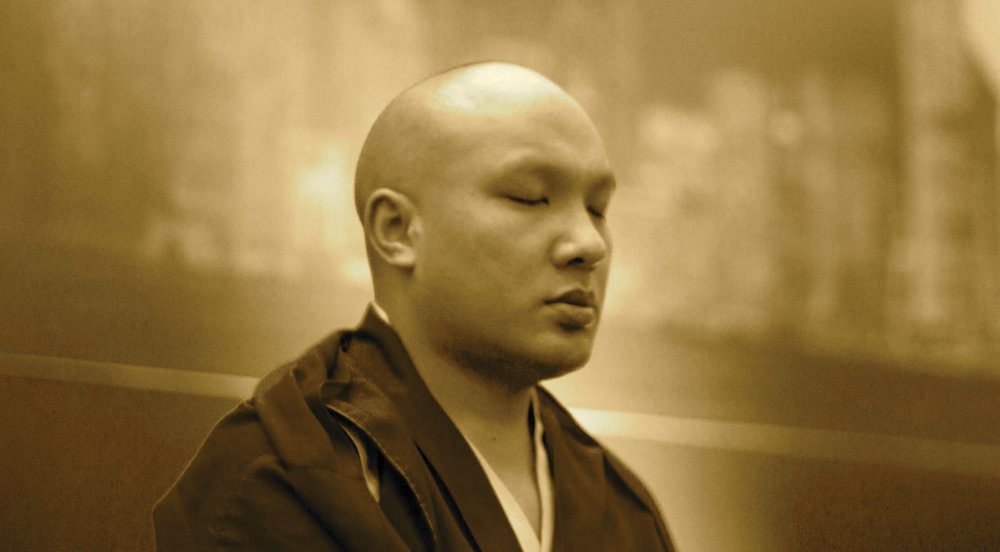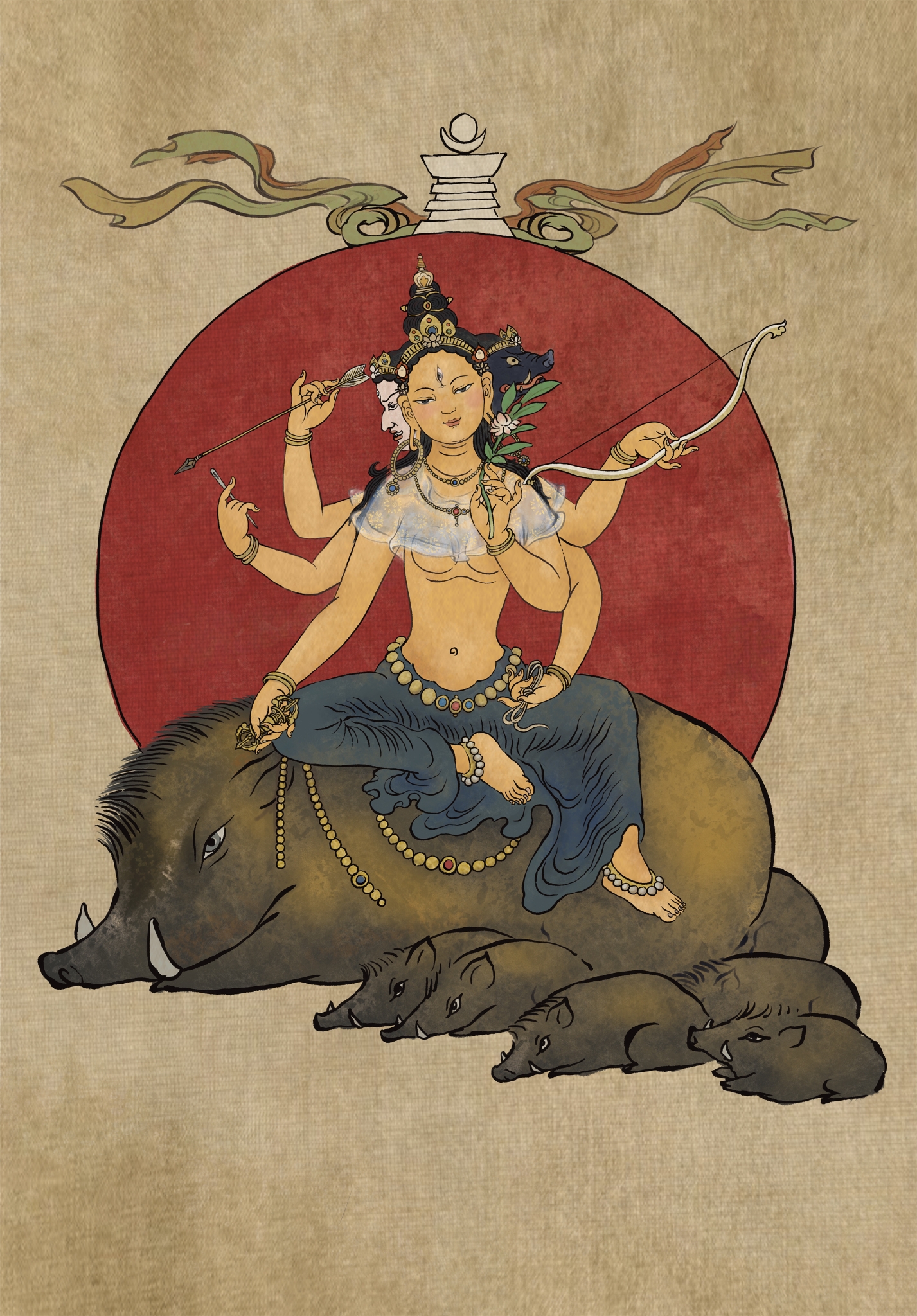Whoever grasps and upholds
These Ravishing Pearl Rosary Praises,
May the teachings vastly expand for others,
Like a blissful sweet Summer lake!
–excerpt from Praises to Mārīcī contained in the ‘Thousand-Fold Offerings to Mārīcī’ by 17th Karmapa (tr, Adele Tomlin)
On 17th February 2022, for the final day of the online Kagyu Monlam, the 17th Karmapa released another new creation and premiered the performance (see video recording here) of a new sadhana he composed: ‘Thousand-Offering’ puja and Praises for Mārīcī.
In the colophon of the Praises, published here in Tibetan, which form the final part of the ritual, the Karmapa explains how he composed it ‘on the 13th February 2022, while joined with a lucid, bright mind’ and he dedicates it to increasing virtue and auspiciousness.
The text of the ritual is in Tibetan only (with phonetics). As it has not yet been translated into English, and for those who don’t read or understand Tibetan but who are eager to find out more about it, I offer an overview here of the content and structure of the new ritual together with some translated excerpts from the Praises. If no translation is done of it in the future, then time permitting, I will make a first, humble attempt at it! First, is a transcript of what the Karmapa said about the new Sadhana and Praises.
Music? Diamonds and Pearls by Prince and For Your Love by the Yardbirds….’I’d give the moon if it were mine to give For your love I’d give the stars and the sun before I live For your love!’
Compiled and translated by Adele Tomlin, 19th February 2022.
17TH KARMAPA’S INTRODUCTION AND ORAL TRANSMISSION OF THE NEW SADHANA

The Karmapa first gave the oral transmission of the Dharani of Mārīcī, which he had recently translated from Chinese into Tibetan (for more on that see here), he explained that:
“Today, I will give the oral transmission of the Dharani of Mārīcī first. In the Tibetan canon, we have several different translations of the Sutra of the Dharani of Mārīcī, in Chinese we have several translations of the Dharani of different lengths.
There was the master who came from Sri Lanka to China in the 7th or 8th Century, Amoghavajra translated the Sutra the Dharani of Mārīcī. He translated a couple of them and I translated one of these into Tibetan. The particular reason for doing that is in the description of the background to the text at the beginning, it describes who was requesting the Sutra and that is very clear. I thought that was very good, so I translated it into Tibetan.
Generally there is no lineage of this transmission, but the Sutra of the Dharani of Mārīcī and the one I translated are the same meaning. There is a difference in the length of the words. However, in actuality, I have the transmission. So first will give the transmission of the Sutra of the Dharani of Mārīcī.”
THE TEXT ITSELF AND PURPOSE OF RECITING IT

After the oral transmission had been completed, the Karmapa continued:
“As I mentioned before, we have all the texts that we need to recite, but the actual ritual text with all the notes is not ready, so there are the texts that have been distributed in the monasteries as it is possible if you distribute it freely over the internet, you are transmitting something that is not quite right, it is not complete, so that is not good. Therefore, we may make a book or a text format and distribute it to everyone. But I would like to take the opportunity to say, as I said to the Monastic communities yesterday, Mārīcī is an emanation of the Buddha Vairocana. This is generally said. Some people say she is Chenrezig’s emanation. In any case, Mārīcī is expecially for illness and epidemics. Also, for eliminating the danger of thieves, or dangers one encounters on the road. So she eliminates all the enemies on the way, all the difficulties we experience while on the way road while travelling.
The particular reason we are doing this thousand-fold offering to Mārīcī is that I thought it would be of benefit and improve the situation of this ongoing epidemic. I thought of doing this before, and in fact all of last year, but I was unable to do it. Now, while we are holding this special Monlam, I thought it was a good idea to do it. My Dharma friends told me and I thought it would be good to put some effort in and composed this ritual. I don’t have much else to say.”
The Karmapa then explained to the monastic sangha how to set up and make the offering in Tibetan only. He then explained the time it would take to recite the practice:
“There is a quite a lot to recite. At first, it was quite long and then I shortened it because originally it was four hours, so now it will take about three hours. As it is a bit long, we will have a tea break halfway through.”
‘THOUSAND-FOLD OFFERINGS’ TO MARICI
SADHANA STRUCTURE

PRAISE TO THE TWELVE DEEDS OF THE BUDDHA
The ritual began with a Praise to the Twelve Deeds of the Buddha.
FIELD OF MERIT
The next section was a visualization of Mārīcī and the field of merit, making offerings, seven branch prayer, which includes refuge, giving rise to bodhicitta and so on.
SELF-VISUALISATION – OFFERINGS, INVITATION, EMPOWERMENT

Then there was a detailed visualization of oneself as Mārīcī, arising from on a white lotus and moon mandala, an AH transforms into a seed syllable golden MAM, oneself as Mārīcī with a stupa as crown ornament; three heads, right white, left boar sow’s head. Six arms, right holding bow, vajra and needle. Left holding bow, thread and a floral branch from a tree that is ‘beyond suffering’. Right leg drawn in and left extended, seated on a golden boar pig. Surrounded by golden pigs and a retinue of goddesses. She is invited together with her retinue, then the seven offerings are made and the field dissolves into oneself.
Again from the MAM the five empowering Buddhas are invited and offerings are made to them. They bestow empowerment and then more offerings and praises.

Then at the centre of one’s heart is the seed syllable māṃ, which is surrounded by the mantra, this revolves clockwise:
ཨོཾ་མཱ་རཱི་ཙྱཻ་མཱཾ་སྭཱ་ཧཱ། Oṃ mārīche māṃ svāha

This is then followed by a recitation of this shorter mantra
ཨོཾ་མཱ་རཱི་ཙྱཻ་ སྭཱ་ཧཱ། Oṃ mārīche svāha
Then a longer mantra
ཨོཾ་མཱ་རཱི་ཙྱཻ་མཱཾ་ཧཱུཾ་ཧཱུཾ་ཕཊ་ཕཊ་སྭཱ་ཧཱ། Oṃ mārīche māṃ huṃ huṃ phet phet svāha

FRONT VISUALISATION
During the front-visualisation a vase is visualized and Mārīcī is visualized seated on the boar sow surrounded by a retinue of goddesses, offerings are made. The five empowering Buddhas arise and are invited again, offerings are made to them. They bestow the empowerment with the vase. Then there are the offerings to Mārīcī and mantra accumulation.
OFFERINGS
The offerings follow a simple structure and repetition, of the seven types of offering drinking water, bathing water, flowers, incense, lights, perfume, food and music:
In the infinite worldly realms, all [OFFERING NAME] however many exist,
I arrange with devotion and offer to the assembly of mandala deities.

MANTRA AND SEED SYLLABLE
 In this sadhana, the Karmapa uses the seed syllable MAM (pronounced MAAM, like the polite form of addressing a woman, ‘yes, maam’ ). Normally, the seed syllable is MUM, (like mother). The mantra used for the main accumulation is (as pictured):
In this sadhana, the Karmapa uses the seed syllable MAM (pronounced MAAM, like the polite form of addressing a woman, ‘yes, maam’ ). Normally, the seed syllable is MUM, (like mother). The mantra used for the main accumulation is (as pictured):
Om mārīche mām svaha
RAVISHING PEARL ROSARY: PRAISES TO MARICI

After the accumulation of offerings and mantras, the sadhana finished with an extensive and overflowing twenty-three verses praises to Mārīcī. The Tibetan text of these Praises with the colophon (which has not yet been translated into English) is entitled the Ravishing Pearl Rosary (mu tig phreng mdzes). The Praises can be heard from 2.32.29 in the video recording here.
While chanting it along with the Karmapa and the Umdze, one could feel the overwhelming devotion and emotion within it, like an overflowing vase of golden ectar, inexhaustible and blissful. The Karmapa uses stunning poetic metaphors of natural beauty such as jewels, pearls, lakes, flowers, great waves, waxing moons to praise the golden goddess. I have humbly attempted a translation of the last four verses and re-produce them here below with Tibetan and phonetics.
ནད་མེད་ཚེ་དང་རླབས་ཆེན་རྣམ་དཔྱོད་དང་། །
nemé tsé dang labchen namchö dang
དགེ་ཚོགས་ཀུན་གྱི་རྩ་བ་དད་སེམས་ཏེ། །
gé tsok kün gyi tsawa dé sem té
འཇིག་རྟེན་འཇིག་རྟེན་འདས་པའི་ཡོན་ཏན་རྣམས། །
jikten jikten depé yönten nam
ཡར་ངོའི་ཟླ་ལྟར་འཕེལ་ཞིང་རྒྱས་པར་ཤོག །
yar ngö da tar pel zhing gyepar shok
May life without sickness, stupendous intellect,
All roots of accumulated virtue of a faithful mind,
QualIties beyond the worldly world,
Like a waxing moon, increase and expand!
༢༠ ཐུབ་པའི་བསྟན་པ་སྤྱི་དང་བྱེ་བྲག་རྣམས། །
tubpé tenpa chi dang jedrak nam
མི་ཉམས་གོང་དུ་སྤེལ་བའི་བསམ་སྦྱོར་ལ། །
mi nyam gong du pelwé samjor la
བར་དུ་གཅོད་པའི་བདུད་རིགས་ཐམས་ཅད་ཀྱང་། །
bardu chöpé dü rik tamché kyang
ཚར་གཅོད་རྗེས་སུ་འཛིན་པའི་མཐུ་ཐོབ་ཤོག །
tsarchö jesu dzinpé tu tob shok
May the teachings, particular and general of the Thubpa (Sage)
Not degenerate, increase and be mentally integrated.
May all types of ‘demonic’ obstacles be severed
Vanquishing all harm, hold us in your power!
༢༡ བདག་ནི་མཐོང་ཐོས་རེག་པ་ཙམ་གྱིས་ཀྱང་། །
dak ni tong tö rekpa tsam gyi kyang
འགྲོ་བའི་ཡིད་ཀྱི་གདུང་བ་སེལ་བ་དང་། །
drowé yi kyi dungwa selwa dang
ཡིད་བཞིན་ནོར་དང་བུམ་པ་བཟང་པོ་ལྟར། །
yizhin nor dang bumpa zangpo tar
འདོད་པའི་རེ་བ་ཡོངས་སུ་སྐོང་བར་ཤོག །
döpé rewa yongsu kongwar shok
Sovereign, merely by seeing, hearing or touching you
Tormented minds of beings are relieved.
Like an exquisite vase and wish-fulfilling jewel
May all hopes and desires be completely satisfied!
༢༢ འདི་ནས་སྐྱེ་བའི་ཕྲེང་བ་ཐམས་ཅད་དུ། །
di né kyewé trengwa tamché du
ཐུགས་རྗེའི་ཕྱག་གིས་ནམ་ཡང་མི་གཏོང་བར། །
tukjé chak gi namyang mi tongwar
མུ་མེད་སྲིད་པར་འཁྱམས་པའི་འགྲོ་བ་ལ། །
mumé sipar khyampé drowa la
གཉེན་ཞིང་བྱམས་པ་ཁྱོད་དང་མཚུངས་གྱུར་ཅིག །
nyen zhing jampa khyö dang tsung gyur chik
From this, may the rosary of all lifetimes
Never be dropped from your palm of compassion.
For those wandering in endless existence
May relative and loved ones be the same as you!
༢༣ དེ་ལྟར་བསྟོད་པའི་མུ་ཏིག་ཕྲེང་མཛེས་འདི། །
detar töpé mutik treng dzé di
སུ་ཞིག་འཆང་དང་འཛིན་པར་བྱེད་པའམ། །
su zhik chang dang dzinpar jepa am
གཞན་ལ་རྒྱ་ཆེར་སྟོན་པར་བྱེད་པ་རྣམས། །
zhen la gyacher tönpar jepa nam
བདེ་ལེགས་དབྱར་གྱི་མཚོ་ལྟར་རྒྱས་གྱུར་ཅིག །
delek yar gyi tso tar gyé gyur chik
Like these Ravishing Pearl Rosary Praises,
Whomever grasps and upholds them,
May the teachings vastly expand for others,
Like a blissful sweet Summer lake!
ཅེས་པ་འདིའང་འཕགས་མ་འོད་ཟེར་ཅན་མའི་སྟོང་མཆོད་གསར་རྩོམ་གྱི་ཆ་ལག་ཏུ་དམིགས་ནས། དཔལ་ཀརྨ་པའི་མཚན་ཙམ་འཛིན་པ། ཨོ་རྒྱན་ཕྲིན་ལས་སུ་འབོད་པ་དེས་སྤྱི་ལོ་ ༢༠༢༢ ཟླ་ ༢ ཚེས་ ༡༣ ཉིན་ཡིད་རབ་ཏུ་དང་བས་སྦྱར་བ་འདིས་ཀྱང་བཀྲ་ཤིས་གྱི་དགེ་མཚན་རབ་ཏུ་རྒྱས་པར་གྱུར་ཅིག་གུ།
This Thousand-Fold Offerings to Noble Ozer Chenma was composed by the one merely named ‘Glorious Karmapa’, Ogyen Trinley Dorje on the 13th February 2022, with a mind completely joined with lucidity. May auspiciousness and virtue increase!
Written and translated by Adele Tomlin, 19th February 2022.


Sorry, is the text of this sadhana available anywhere? Preferrably in electronic format
Hello, I am not aware of it being published anywhere other than in the Kagyu Monlam Prayer book perhaps? I have not seen it on Dharma E-Books. Perhaps you can email them and ask them? 🙂